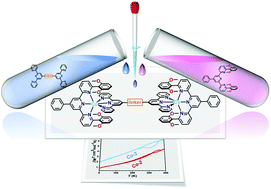Construction of spin-crossover dinuclear cobalt(ii) compounds based on complementary terpyridine ligand pairing†
Abstract
The self-assembly of multinuclear SCO complexes is appealing in which unique properties may be discovered due to enhanced intramolecular and intermolecular interactions. In this work, three dinuclear cobalt(II) complexes, named Co-1, Co-2, and Co-3, were prepared based on a complementary terpyridine ligand pair strategy. The complexes were accurately synthesized by the solvothermal method in which dinuclear complexes were directional assemblies from cobalt(II) ions, terpy bearing 2,6-dimethoxyphenyl substituents at the terpyridyl 6,6′′-positions, and ditopic terpy built with different linkers (alkynyl for 1, diynyl for 2, and phenyl for 3). Single-crystal structure determinations reveal that all compounds possess a central symmetric molecular structure, so that two cobalt(II) units are identical in the solid state. Their spin crossover behaviours were investigated through variable-temperature magnetic susceptibility studies. Co-1 undergoes limited SCO with a large population of low spin state (S = 1/2) in the measured temperatures. Co-2 and Co-3 exhibit solvent-modulated SCO behaviour. Impressively, the de-solvated samples show a repeatable thermal hysteresis loop around the room temperature region. This work demonstrates that complementary terpyridine ligand pairing is a practical approach to accurate and directional construction of multinuclear SCO-active compounds.



 Please wait while we load your content...
Please wait while we load your content...